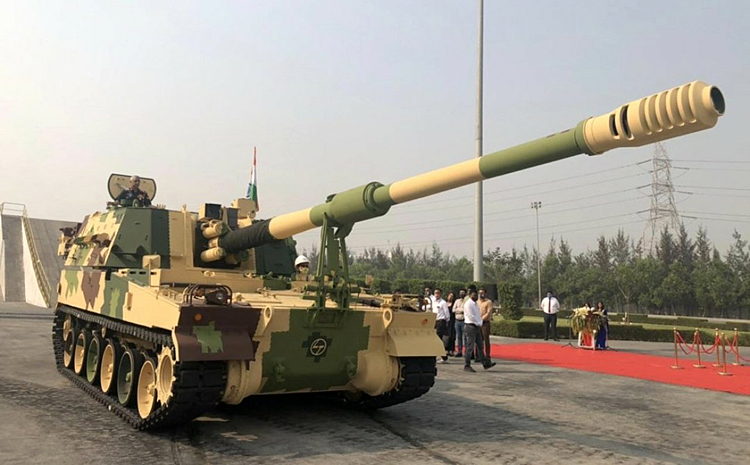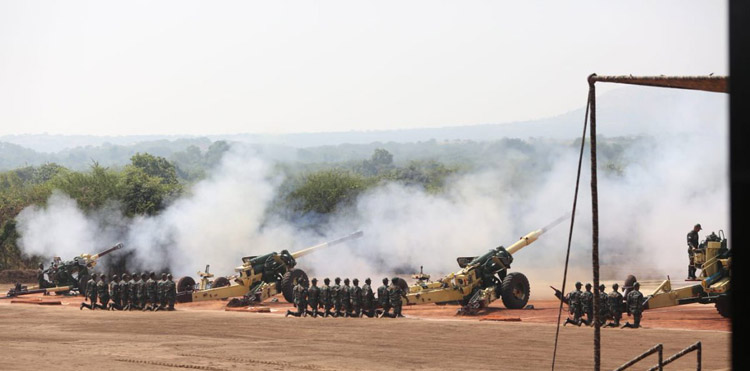INDIAN ARMED FORCES CHIEFS ON OUR RELENTLESS AND FOCUSED PUBLISHING EFFORTS

The insightful articles, inspiring narrations and analytical perspectives presented by the Editorial Team, establish an alluring connect with the reader. My compliments and best wishes to SP Guide Publications.

"Over the past 60 years, the growth of SP Guide Publications has mirrored the rising stature of Indian Navy. Its well-researched and informative magazines on Defence and Aerospace sector have served to shape an educated opinion of our military personnel, policy makers and the public alike. I wish SP's Publication team continued success, fair winds and following seas in all future endeavour!"

Since, its inception in 1964, SP Guide Publications has consistently demonstrated commitment to high-quality journalism in the aerospace and defence sectors, earning a well-deserved reputation as Asia's largest media house in this domain. I wish SP Guide Publications continued success in its pursuit of excellence.
- MoD initiates comprehensive review of Defence Acquisition Procedure 2020, pushes for defence reforms
- G7: The Swansong
- Kalinga Connect: South Asia to Polynesia
- Must Credit DRDO for Operation Sindoor, now what is next for defence R&D?
- The layered Air Defence systems that worked superbly, the key element of Operation Sindoor
- Operation Sindoor | Day 2 DGMOs Briefing
- Operation Sindoor: Resolute yet Restrained
K9 Vajra Mountain Trials Successful
According to sources in the defence and security establishment, trials of 3 x K9 Vajra which were sent to Ladakh earlier this year have been successful and because it is tracked, the movement in the mountains becomes easier so the system can be deployed strategically.
 |
The Author is Former Director General of Information Systems and A Special Forces Veteran, Indian Army |

In 2017, the Indian Army ordered 100 x K9 Vajra Tracked Self-Propelled Howitzers under the 4,500 crore deal from Larsen and Toubro (L&T) for five Artillery regiments with 20 x K9 Vajra each. L&T had signed a transfer of technology (ToT) contract with the South Korean firm, Hanwha Corporation, which is the original manufacturer of the gun system known as K9 Thunder. L&T delivered the 100th K9 Vajra to the Indian Army in February 2021 well before the time required.
According to L&T, the K9 Vajra delivered to the Army have more than 80 per cent indigenous work packages and above 50 per cent indigenisation (by value) at the program level. L&T says it had commenced indigenisation right from the inception of the program, by replacing 14 critical systems in the South Korean ‘K9 Thunder’ with indigenously developed and produced systems for the trial gun fielded for user evaluation trials.
According to L&T, the K9 Vajra delivered to the Army have more than 80 per cent indigenous work packages and above 50 per cent indigenisation (by value) at the programme level
News reports of August 9 quoting sources in the defence and security establishment revealed that trials of 3 x K9 Vajra which were sent to Ladakh earlier this year have been successful. According to a source, “The K9 Vajra is a beautiful and formidable gun system. It has a high range and because it is tracked, the movement in the mountains becomes easier. With its range and motion capability, the system can be deployed strategically.”
Plans are now reportedly being finalised to order at least two more regiments of the K9 155mm/52 calibre howitzers that would be deployed in the mountains and the process to work out the cost criteria for the additional 40 K9 Vajras is on. The Army earlier had no plans to induct additional K9 Vajras. For the mountains, the Army has already ordered the M777 lightweight howitzers because the M777 lightweight howitzers can reach areas in mountains where the heavier K9 Vajra Howitzers cannot reach.
The delivery of the M777 lightweight howitzers is ongoing but will take time to be completed. However, tensions with China have led to more focus along the Line of Actual Control (LAC). Moreover, the production of Dhanush guns is halted with the Central Bureau of Investigation (CBI) discovering that Gun Carriage Factory, Jabalpur had been using faulty wire race roller bearings that had not passed the tests in the six Dhanush guns delivered to the Army in 2019.
Plans are now being finalised to order at least two more regiments of the K9 155mm/52 calibre howitzers that would be deployed in the mountains and the process to work out the cost criteria for the additional 40 K9 Vajras is on
The M777 lightweight howitzers can be picked up by helicopters and taken to forward locations in the mountains. These guns have a maximum range of about 40 km with specialised munitions. In comparison, the Vajra has a range of over 50 km depending on the munitions used. In view of the continuing situation along the LAC, it is felt that a combination of the M777 light howitzers, K9 Vajra along with other systems already in service and the ones that will come in future will add to the lethality of the Army’s firepower.
Incidentally, L&T and the DRDO are working on a ‘Vajra tank’, which would be a light tank. The idea is to replace the heavy 155mm gun with a 105mm or 120mm gun. The chassis or the hull remains the same but a lighter gun would mean that the weight would be drastically reduced as the design of the turret also changes.

The Army had issued a RFI (Request For Information) in April 2021 inviting responses from overseas and domestic vendors for its planned procurement of 350 locally manufactured ‘light tanks’ weighing less than 25 tons along with performance-based logistics, niche technologies, engineering support package, and other maintenance and training requirements.
The delivery of the M777 lightweight howitzers is ongoing but will take time to be completed. The production of Dhanush guns is halted with the CBI discovering use of faulty wire race roller bearings that had not passed the tests in the six Dhanush guns delivered to the Army in 2019.
The RFI calls for a light tank featuring a multiple, modular and upgradable weapon system with the capability to destroy and offer countermeasures to varied threats, also featuring multiple weapons for anti-aircraft and ground role with different calibre assisted with remote control weapon station; the tank should employ modern advance multipurpose ‘smart munitions’ with a gun able to fire anti-tank guided missiles; auxiliary power unit; preheated, environment control unit; anti-drone capability; UAV jammers and; net-enabled functions.The mention of procurement in phased manner under ‘Make in India’ indicates that the DRDO may be chosen as one developer, if not capturing the whole contract.
India needs to become a potent military power in the shortest possible time for meeting the present and emerging threats. Ironically, despite issuing periodic defence procurement and acquisition procedures, we have done little to reduce the red tape, be it in accepting the necessity, elaborate procedure of examining responses to the RFI, selecting developer (s) for the prototypes, trials, awarding of contract, induction schedule corresponding with operational requirements, political considerations and the like.
Despite issuing periodic defence procurement and acquisition procedures, we have done little to reduce the red tape
Above is the precise reason why General M.M. Naravane, Chief of the Army Staff, recently stated that we need a ‘Revolution in Bureaucratic Affairs’ for hastening up procurements. Will the politico-bureaucratic dispensation pay heed to the Chief’s call?





